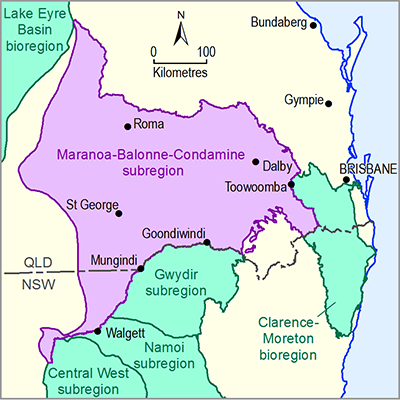In the judgement of the Assessment team, extending this assessment should focus on incorporating surface water modelling and representing surface water – groundwater interactions, including analysing impacts to streams in areas where drawdown is predicted at the surface (within the zone of potential hydrological change). The following key knowledge gaps identify where confidence in results can be improved through future work.
Hydrological modelling
The revised OGIA model (OGIA, 2016) addressed many of the limitations identified in the qualitative uncertainty analysis (Table 13 in Janardhanan et al. (2016)). Improvements include representation of regional geology, hydrostratigraphy and faults, as well as model discretisation, parameterisation and calibration. The greatest opportunities to improve model predictions in this assessment involve incorporation of surface water modelling and surface water – groundwater interactions to quantify changes in streams and the regional watertable that may occur as a result of coal resource development. Water quality models and data would allow related hazards to be addressed.
Assessing impacts in the landscape
As surface water modelling was not undertaken, the assessment of ecological and ecosystem impacts is limited to an overlay analysis, a summary of the hydrological changes and a conceptual understanding of the ecosystems, using landscape classes. While this is valuable, receptor impact models, used to understand the potential impacts of hydrological changes on an ecosystem or landscape, would provide better indicators of potential changes in ecosystems. These models use indicators in the ecosystem, such as the condition of the breeding habitat for a given species, or canopy cover of river red gums, to assess the potential impact of hydrological changes.
Model resolution
There is a high level of confidence in the ability of the assessment to rule out areas that are not subject to hydrological change. This is due to the ability of the OGIA model to reflect broad-scale hydrological changes related to impacts that may accumulate from multiple sites and types of coal resource development. Where changes are predicted, and particularly close to the mine or CSG operations, the assessment team is confident in asserting that hydrological changes may occur, but less confident in the precise magnitude or extent of propagation of those changes from depth to the surface. The underlying spatial resolution for the impact and risk analysis in this assessment is 2.25 km2. Although fit for purpose, a finer resolution model would be more suitable for local-scale-analysis.
Climate change and land use
In comparing results under two different futures, factors such as climate change or land use are held constant in this assessment. Future assessments could look to include these and other stressors to more fully predict cumulative impacts on a landscape scale.
See sections titled ‘Gaps’ in: Description of water-dependent asset register, product 1.3 (Mitchell et al., 2015) Current water accounts and water quality, product 1.5 (Cassel et al., 2015) Conceptual modelling, product 2.3 (Holland et al., 2016) Groundwater numerical modelling, product 2.6.2 (Janardhanan et al., 2016) Impact and risk analysis, product 3-4 (Holland et al., 2017) See www.bioregionalassessments.gov.au for links to information about all datasets used or created, most of which can be downloaded from data.gov.au.FIND MORE INFORMATION

Product Finalisation date
- Explore this assessment
- About the subregion
- How could coal resource development result in hydrological changes?
- What are the potential hydrological changes?
- What are the potential impacts of additional coal resource development on the landscape?
- What are the potential impacts of additional coal resource development on water-dependent assets?
- How to use this assessment
- Building on this assessment
- References and further reading
- Datasets
- Contributors to the Technical Programme
- Acknowledgements
- Citation
